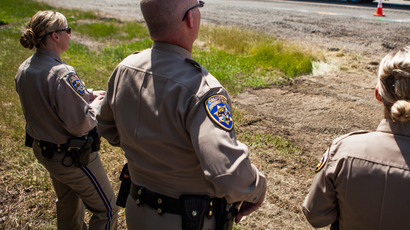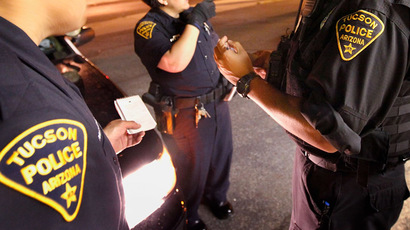Pointergate: The most racist political scandal of 2014?

A white mayor, willing to criticize her city’s at-times abusive police department, poses for a photo with a community get-out-the-vote volunteer, a young black man on probation for a non-violent felony. In 2014 America, brace for racism.
‘Pointergate’, as it has been dubbed, involves a now infamous picture, taken just before last week’s midterm election, in which Minneapolis Mayor Betsy Hodges and Navell Gordon, a volunteer from the nonprofit Neighborhoods Organizing for Change (NOC), posed for photos while Hodges accompanied Gordon in canvassing door-to-door to encourage residents to register to vote.
Gordon, who has worked for two years as an organizer for NOC, is also on probation for selling drugs, possession, and illegal possession of a firearm. He has not violated his probation, according to reports.
In one of the photos, Hodges and Gordon pointed at one another. Pointing, as discovered by Vox, is a common move for Hodges when she poses for photos. Nevertheless, local ABC affiliate KSTP ran a news story the next week claiming that Hodges posed with “a convicted felon while flashing a known gang sign.”
KSTP’s story - accompanied with photos that blurred out Gordon’s face - was only sourced with law-enforcement interviewees and framed Gordon as nothing but a felon, too toxic for the mayor to associate with. Responding to the mayor’s claim that she was pointing in the photo, retired Minneapolis police officer Michael Quinn said, “She can't be that naive. I cannot imagine."

"She is legitimizing these people. She is legitimizing gangs who are killing our children in Minneapolis and I just can't believe it. It hurts," Quinn told KSTP.
Immediate backlash followed, but the story remains on KSTP’s website without an apology or acknowledgement of the controversy it stoked.
The KSTP story also dwelled on Gordon’s criminal history, and not his attempts to make amends since then.
"I made some mistakes in life," Gordon said in a NOC video posted on the same day as KSTP's story. "I'm not ashamed to say that. But I'm working on fixing that right now, so I can be able to vote for my next president."
NOC defended Gordon’s work, calling KSTP’s depiction of him unfair.
"Navell has been working as an organizer with Neighborhoods Organizing for Change for two years. This year, he was a leader in our civic engagement work, part of a team that knocked on over 55,000 doors," NOC said in a statement Monday.
Observers have said that Gordon was a “convenient scapegoat” in a power struggle between the Minneapolis Police Department and Mayor Hodges. In the past, Hodges has been outspoken in her criticism of the Minneapolis Police.
"Some officers abuse the trust that is afforded to them and take advantage of their roles to do harm rather than prevent it," Hodges wrote to Minneapolis residents the same day the US Department of Justice released the findings of a year-long review that recommended the Minneapolis Police address rogue police officers.
Police also resisted Hodges body-camera initiative, fueling animosity, according to Nekima Levy-Pounds, a law professor at the University of St. Thomas Law School.
“I posit, another reason the Mayor was targeted in the story is the fact that she has demonstrated courage by speaking publicly about much-needed reforms within the Minneapolis Police Department, including the body-cam pilot project that is being rolled out today,”wrote Levy-Pounds in the Star Tribune. “Resistance to change comes in many forms, and sadly this is one of the worst examples of such resistance. The young man in the photo was merely a convenient scapegoat for a larger agenda.”

For his part, Gordon said he was having a good time going door-to-door with the mayor, and that he cannot believe the reaction since the photos were taken.
“When I saw my face blurred out, that felt like something racist,” he told The Huffington Post. “Because I'm African-American, but they got the mayor's face showing. I'm pointing at the mayor. It's not a gang sign. How would I be in a gang if I've been canvassing for two years, going door to door? What kind of gang member pops up at everybody's door? I'm a known member of one of the bigger gangs in Minnesota, and I knock on everybody's door? That's just crazy.
“They could have put us on the news for the mayor going out and canvassing with Neighborhoods Organizing for Change -- why did they put that up there?”
In her Star Tribune column, Levy-Pounds addressed how Gordon became that convenient scapegoat in a society that is often immediately suspicious of young men of color.
“The constant portrayal of young black men as gangsters, thugs, and criminals can be seen nearly every night on the news or in newspapers in Minnesota and around the country. Undoubtedly these negative perceptions contributed to the untimely deaths of Trayvon Martin, Mike Brown, Jordan Davis, and countless other victims. The daily replaying of the narrative of blackness as evil, dangerous, and in the case of Mayor Hodges, contagious, has a cumulative effect on the American psyche and permanently warps our perceptions of the 'other.'”














